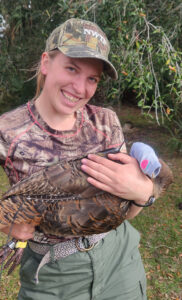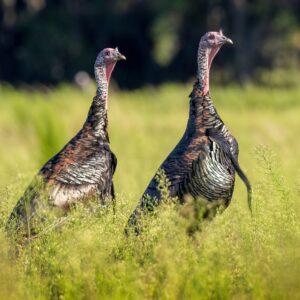During Thanksgiving week, the hosts of the WSLR program interview an expert of the big birds.
By Johannes Werner
Original Air Date: November 26, 2025
Host: “Our Changing Environment” this week is going turkey. Wild turkey, that is. On their show that aired Tuesday, hosts Jono Miller and Julie Morris interviewed Juliana Ofalt. She is the Florida Wildlife Commission expert on wild turkeys, and we are giving you a few glimpses on the life of these big birds.
[Wild turkey call]
Johannes Werner: That’s the gobble of the wild turkey, the center of Ofalt’s professional attention. But did you know they also purr?

Juliana Ofalt
Juliana Ofalt: The vocalizations that they make to each other is also something that’s always fascinated me. Just all of the different, distinct vocalizations that they can make and communicate with is really—
Jono Miller: They have sort-of a—the females have sort-of a purr, don’t they?
JO: Yeah, they often will. And you have to be pretty close to hear that, and it’s just this very soft purr.
JW: Julianna Ofalt is in charge of keeping track of the turkey population in the state. As part of that, she is also involved in research.
In collaboration with the University of Florida, she is tracking wild turkeys in the southern portion of the peninsula. One of the intents: Making sure hunting happens in a way that is sustainable for the wild turkey population.
Wild turkey habitats in Florida and populations have been stable, Ofalt says. They can live in the swamps of South Florida, in sawgrass palmetto of this area, and in the open pine of the Panhandle. Efforts to repopulate part of the Everglades with turkey have failed, but the big birds have adapted to living in suburban environments.
JO: Wild turkeys are adaptable, and they’re generalists as well, so they can inhabit a wide range of habitats and thrive on different food items, so they can adjust to suburban and even urban living sometimes. That is something we do see in Florida specifically quite often, as we’ll see wild turkeys in residential neighborhoods coming in and out. Our residents do have to, in many cases, live with wildlife, including turkeys. The range of turkeys in Florida has stayed relatively consistent since restoration. We have areas where there is habitat loss—where wild turkeys are losing habitat—but, as we said, they do adjust well, so their range is relatively stable across the state.
JW: They nest on the ground, and that is one of wild turkeys’ biggest vulnerabilities.

Wild turkey in Florida. Photo courtesy Florida Wildlife Federation
JO: Wild turkeys usually roost in trees, but suddenly, she’s sitting on the ground all day, all night. Not only is that a really vulnerable time for the nest but also the hen. A lot of research such as ours is focusing on this nesting period. She incubates that nest for usually around 28 days before hatching it out. During that time, you have threats from predators of the hen herself—including coyotes, bobcats—and then predators of the eggs in the next, which could be raccoons, possums, snakes, crows—a wide variety of species can prey on that nest, additionally. Really, we see in the southeast, some studies show only about 25% of nests that are laid are actually hatching.
JW: Turkey hunting in Florida is allowed in spring and in fall. In other words, it’s going on right now. Hunters can kill two birds in each season. On public lands, the state may restrict the number of hunters each season. State Road 70 is the equator that divides Florida during hunting season. South of the line, the season begins two weeks earlier. Hunters must report each kill to the Florida Fish and Wildlife Commission.
Ofalt works with hunters day in, day out. She explained what the “grand slam” is for turkey hunters.
JO: It’s extremely popular in the turkey hunting community, this concept called the grand slam. The grand slam is when you kill one of each of the four main subspecies, which would be the Merriam’s, the Rio, the Eastern and the Osceola. This does bring quite a bit of attention to Florida because folks have to come to Florida to harvest their Osceola wild turkey. We do get many hunters that come for that purpose.
Cooperation with hunters contributes a lot of information that helps protect the species, Ofalt says.
JO: I’m really drawn to the turkey hunting community and their interest in turkey conservation. I find them to be a group that is really interested in the biology of the species and the population status and growing that.
JW: If you want to learn more about wild turkeys, listen to the full one-hour interview. Go to wslr.org, click on “archive,” scroll down to the Tuesday shows this week, and look for “Our Changing Environment.”
[Wild turkey call]
WSLR News aims to keep the local community informed with our 1/2 hour local news show, quarterly newspaper and social media feeds. The local news broadcast airs on Wednesdays and Fridays at 6pm.